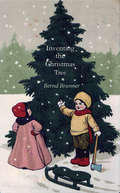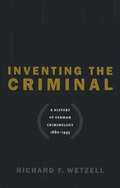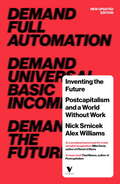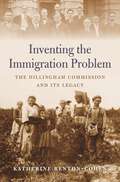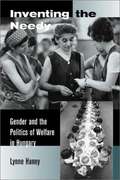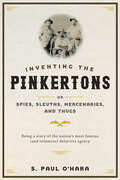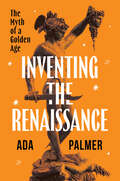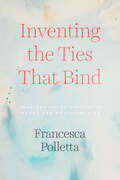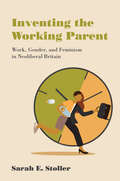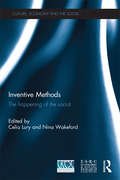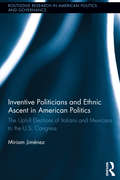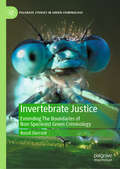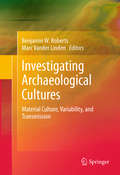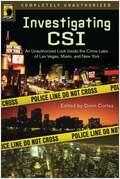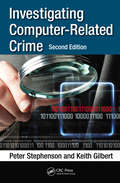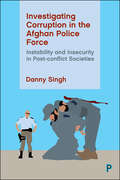- Table View
- List View
Inventing the Christmas Tree
by Bernd Brunner Benjamin A. SmithA colorfully decorated Christmas tree, lit with twinkling lights, provokes awe and delight. We understand the lighted tree as a central symbol of the Christmas season, but what are the roots of the tradition? Who first thought to bedeck a tree, to bring it inside? How and where did the local activity grow into a widespread tradition, and how has the Christmas tree traveled across time and continents? Bernd Brunner's brief history--enriched by a selection of delightful and unusual historical illustrations--spans many centuries and cultures to illuminate the mysteries of the Christmas tree and its enduring hold on the human imagination. Tracing various European traditions from the Middle Ages forward, Brunner finds that only in the nineteenth century did Christmas trees become common in European family homes. In North America, the imported custom soon fascinated, though some found the tree not quite compatible with a Puritan mindset. Brunner explores how the Christmas tree entered mainstream American culture and how in recent times it has become globally popular. He introduces Jacqueline Kennedy's Nutcracker Tree in the White House, trees used to celebrate the New Year in Turkey, and the world's most expensive Christmas tree, erected in Abu Dhabi. The author also considers the place of the artificial tree and the ecological dimensions of the Christmas tree trade. A book rich with anecdote and insight, Inventing the Christmas Tree will enchant a wide audience.
Inventing the Criminal
by Richard F. WetzellRecent years have witnessed a resurgence of biological research into the causes of crime, but the origins of this kind of research date back to the late nineteenth century. Here, Richard Wetzell presents the first history of German criminology from Imperial Germany through the Weimar Republic to the end of the Third Reich, a period that provided a unique test case for the perils associated with biological explanations of crime.Drawing on a wealth of primary sources from criminological, legal, and psychiatric literature, Wetzell shows that German biomedical research on crime predominated over sociological research and thus contributed to the rise of the eugenics movement and the eventual targeting of criminals for eugenic measures by the Nazi regime. However, he also demonstrates that the development of German criminology was characterized by a constant tension between the criminologists' hereditarian biases and an increasing methodological sophistication that prevented many of them from endorsing the crude genetic determinism and racism that characterized so much of Hitler's regime. As a result, proposals for the sterilization of criminals remained highly controversial during the Nazi years, suggesting that Nazi biological politics left more room for contention than has often been assumed.
Inventing the Egghead
by Aaron LeckliderThroughout the twentieth century, pop songs, magazine articles, plays, posters, and novels in the United States represented intelligence alternately as empowering or threatening. In Inventing the Egghead, cultural historian Aaron Lecklider offers a sharp, entertaining narrative of these sources to reveal how Americans who were not part of the traditional intellectual class negotiated the complicated politics of intelligence within an accelerating mass culture.Central to the book is the concept of brainpower--a term used by Lecklider to capture the ways in which journalists, writers, artists, and others invoked intelligence to embolden the majority of Americans who did not have access to institutions of higher learning. Expressions of brainpower, Lecklider argues, challenged the deeply embedded assumptions in society that intellectual capacity was the province of an educated elite, and that the working class was unreservedly anti-intellectual. Amid changes in work, leisure, and domestic life, brainpower became a means for social transformation in the modern United States. The concept thus provides an exciting vantage point from which to make fresh assessments of ongoing debates over intelligence and access to quality education.Expressions of brainpower in the twentieth century engendered an uncomfortable paradox: they diminished the value of intellectuals (the hapless egghead, for example) while establishing claims to intellectual authority among ordinary women and men, including labor activists, women workers, and African Americans. Reading across historical, literary, and visual media, Lecklider mines popular culture as an arena where the brainpower of ordinary people was commonly invoked and frequently contested.
Inventing the Future
by Alex Williams Nick SrnicekA major new manifesto for a high-tech future free from workNeoliberalism isn't working. Austerity is forcing millions into poverty and many more into precarious work, while the left remains trapped in stagnant political practices that offer no respite. Inventing the Future is a bold new manifest0 for life after capitalism. Against the confused understanding of our high-tech world by both the right and the left, this book claims that the emancipatory and future-oriented possibilities of our society can be reclaimed. Instead of running from a complex future, Nick Srnicek and Alex Williams demand a postcapitaiist economy capable of advancing standards, liberating humanity from work and developing technologies that expand our freedoms.
Inventing the Immigration Problem: The Dillingham Commission and Its Legacy
by Katherine Benton-CohenIn 1907 the U.S. Congress created a joint commission to investigate what many Americans saw as a national crisis: an unprecedented number of immigrants flowing into the United States. Experts—women and men trained in the new field of social science—fanned out across the country to collect data on these fresh arrivals. The trove of information they amassed shaped how Americans thought about immigrants, themselves, and the nation’s place in the world. Katherine Benton-Cohen argues that the Dillingham Commission’s legacy continues to inform the ways that U.S. policy addresses questions raised by immigration, over a century later. Within a decade of its launch, almost all of the commission’s recommendations—including a literacy test, a quota system based on national origin, the continuation of Asian exclusion, and greater federal oversight of immigration policy—were implemented into law. Inventing the Immigration Problem describes the labyrinthine bureaucracy, broad administrative authority, and quantitative record-keeping that followed in the wake of these regulations. Their implementation marks a final turn away from an immigration policy motivated by executive-branch concerns over foreign policy and toward one dictated by domestic labor politics. The Dillingham Commission—which remains the largest immigration study ever conducted in the United States—reflects its particular moment in time when mass immigration, the birth of modern social science, and an aggressive foreign policy fostered a newly robust and optimistic notion of federal power. Its quintessentially Progressive formulation of America’s immigration problem, and its recommendations, endure today in almost every component of immigration policy, control, and enforcement.
Inventing the Needy: Gender and the Politics of Welfare in Hungary
by Lynne A. HaneyThis ambitious, fluid, and engaging book explains the political and social transformation of the Hungarian state from 1948 to the present. Haney reconceptualizes how we might understand the momentous changes of 1989, resisting the usual categories of the socialist past and the capitalist present.
Inventing the Pinkertons; or, Spies, Sleuths, Mercenaries, and Thugs: Being a story of the nation’s most famous (and infamous) detective agency
by S. Paul O'HaraThe fascinating story of the most notorious detective agency in US history.Between 1865 and 1937, Pinkerton’s National Detective Agency was at the center of countless conflicts between capital and labor, bandits and railroads, and strikers and state power. Some believed that the detectives were protecting society from dangerous criminal conspiracies; others thought that armed Pinkertons were capital’s tool to crush worker dissent. Yet the image of the Pinkerton detective also inspired romantic and sensationalist novels, reflected shifting ideals of Victorian manhood, and embodied a particular kind of rough frontier justice. Inventing the Pinkertons examines the evolution of the agency as a pivotal institution in the cultural history of American monopoly capitalism. Historian S. Paul O’Hara intertwines political, social, and cultural history to reveal how Scottish-born founder Allan Pinkerton insinuated his way to power and influence as a purveyor of valuable (and often wildly wrong) intelligence in the Union cause. During Reconstruction, Pinkerton turned his agents into icons of law and order in the Wild West. Finally, he transformed his firm into a for-rent private army in the war of industry against labor. Having begun life as peddlers of information and guardians of mail bags, the Pinkertons became armed mercenaries, protecting scabs and corporate property from angry strikers.O’Hara argues that American capitalists used the Pinkertons to enforce new structures of economic and political order. Yet the infamy of the Pinkerton agent also gave critics and working communities a villain against which to frame their resistance to the new industrial order. Ultimately, Inventing the Pinkertons is a gripping look at how the histories of American capitalism, industrial folklore, and the nation-state converged.
Inventing the Renaissance: The Myth of a Golden Age
by Ada PalmerAn irreverent new take on the Renaissance, which reveals it as anything but Europe’s golden age. From the darkness of a plagued and war-torn Middle Ages, the Renaissance (we’re told) heralds the dawning of a new world—a halcyon age of art, prosperity, and rebirth. Hogwash! or so says award-winning novelist and historian Ada Palmer. In Inventing the Renaissance, Palmer turns her witty and irreverent eye on the fantasies we’ve told ourselves about Europe’s not-so-golden age, myths she sets right with sharp clarity. Palmer’s Renaissance is altogether desperate. Troubled by centuries of conflict, she argues, Europe looked to a long-lost Roman Empire (even its education practices) to save them from unending war. Later historians met their own political challenges with a similarly nostalgic vision, only now they looked to the Renaissance and told a partial story. To right this wrong, Palmer offers fifteen provocative portraits of Renaissance men and women (some famous, some obscure) whose lives reveal a far more diverse, fragile, and wild Renaissance than its glowing reputation suggests.
Inventing the Savage: The Social Construction of Native American Criminality
by Luana Ross“Her book offers many insights into the criminality of Native people, as well as that of women or anyone else who is poor and oppressed.” —Canadian Woman StudiesLuana Ross writes, “Native Americans disappear into Euro-American institutions of confinement at alarming rates. People from my reservation appeared to simply vanish and magically return. [As a child] I did not realize what a ‘real’ prison was and did not give it any thought. I imagined this as normal; that all families had relatives who went away and then returned.”In this pathfinding study, Ross draws upon the life histories of imprisoned Native American women to demonstrate how race/ethnicity, gender, and class contribute to the criminalizing of various behaviors and subsequent incarceration rates. Drawing on the Native women’s own words, she reveals the violence in their lives prior to incarceration, their respective responses to it, and how those responses affect their eventual criminalization and imprisonment. Comparisons with the experiences of white women in the same prison underline the significant role of race in determining women’s experiences within the criminal justice system.“Professor Ross, through painstaking phenomenological analysis, has unmasked some of the ways in which (race, class, and gender) prejudices, and their internalization by individuals targeted by them, exert enormous influence on the processes and outcomes of the American criminal justice system . . . This book will be of tremendous import to a broad, interdisciplinary audience.” —Franke Wilmer, Associate Professor of Political Science, Montana State University
Inventing the Ties That Bind: Imagined Relationships in Moral and Political Life
by Francesca PollettaFrom deciding to hold the door for the person behind you, to resolving for whom you will cast your vote, every day we find ourselves charged with making moral decisions. What steers our choices? And how do we weigh competing priorities and moral convictions? In Inventing the Ties That Bind, Francesca Polletta shows that we do not solve these dilemmas, whether personal or political, based on self-interest alone. Instead, relationships serve as a kind of moral compass. People consider the nature of their ties to one another to know what their obligations are, and in situations that are unfamiliar, they sometimes figure out the right thing to do by imagining themselves in relationships they do not actually have. Polletta takes up a wide range of cases, from debt settlement agencies to the southern civil rights movement, revealing that our relationships and how we imagine them are at the heart of our moral lives—guiding us as we choose whom to help and how we define what it means to treat someone as our equal. In a time of growing polarization, understanding how we make sense of our ties to one another is more urgent than ever.
Inventing the Working Parent: Work, Gender, and Feminism in Neoliberal Britain
by Sarah E. StollerThe first historical examination of working parenthood in the late twentieth century—and how the concepts of &“family-friendly&” work culture and &“work–life balance&” came to be.Since the 1980s, families across the developed West have lived through a revolution on a scale unprecedented since industrialization. With more mothers than ever before in paid work and the rise of the middle-class, dual-income household, we have entered a new era in the history of everyday life: the era of the working parent. In Inventing the Working Parent, Sarah E. Stoller charts the politics that shaped the creation of the phenomenon of working parenthood in Britain as it arose out of a new culture of work.Stoller begins with the first sustained efforts by feminists to mobilize politically on behalf of working parents in the late 1970s and concludes in the context of an emerging national political agenda for working families with the rise of New Labour in the 1990s. She explores how and why the notion of working parenthood emerged as a powerful new political claim and identity category and addresses how feminists used the concept of working parenthood to advocate for new organizational policies and practices. Lastly, Stoller shows how neoliberal capitalism under Margaret Thatcher and subsequent New Labour governments made a family&’s ability to survive on one income nearly impossible—with significant consequences for individual experience, the gendered division of labor, and intimate life.
Invention Of Women: Making An African Sense Of Western Gender Discourses
by Oyeronke OyewumiThe &“woman question,&” this book asserts, is a Western one, and not a proper lens for viewing African society. A work that rethinks gender as a Western construction, The Invention of Women offers a new way of understanding both Yoruban and Western cultures. Author Oyeronke Oyewumi reveals an ideology of biological determinism at the heart of Western social categories-the idea that biology provides the rationale for organizing the social world. And yet, she writes, the concept of &“woman,&” central to this ideology and to Western gender discourses, simply did not exist in Yorubaland, where the body was not the basis of social roles. Oyewumi traces the misapplication of Western, body-oriented concepts of gender through the history of gender discourses in Yoruba studies. Her analysis shows the paradoxical nature of two fundamental assumptions of feminist theory: that gender is socially constructed and that the subordination of women is universal. The Invention of Women demonstrates, to the contrary, that gender was not constructed in old Yoruba society, and that social organization was determined by relative age. A meticulous historical and epistemological account of an African culture on its own terms, this book makes a persuasive argument for a cultural, context-dependent interpretation of social reality. It calls for a reconception of gender discourse and the categories on which such study relies. More than that, the book lays bare the hidden assumptions in the ways these different cultures think. A truly comparative sociology of an African culture and the Western tradition, it will change the way African studies and gender studies proceed.
Inventions in Sociology: Studies in Science and Society
by Sal RestivoThis book presents a collection of old and new essays exploring the author’s unique contributions to the sociology of science, mathematics, logic, robotics, brain, and god. Known for his defense of a strong social constructionist approach to the hard problems in the sociology of science, the power and range of Restivo’s interests and studies are discussed in this unique text. The essays range from his introduction of the sociology of objectivity early in his career to his recent construction of a social brain paradigm. The author situates himself in the context of the leading paradigms in science studies and his relationships with leading figures in the field including Latour, Woolgar, Needham, and D.T. Campbell. The book demonstrates a general theoretical focus on the rejection of transcendence. He rejects Platonism in mathematics and socially situates consciousness, genius, and God. The author’s wide ranging interdisciplinary competencies reflect classical and postmodern influences and will be an invaluable reference for researchers working in this field.
Inventive Methods: The Happening of the Social (CRESC)
by Celia Lury and Nina WakefordSocial and cultural research has changed dramatically in the last few years in response to changing conceptions of the empirical, an intensification of interest in interdisciplinary work, and the growing need to communicate with diverse users and audiences. Methods texts, however, have not kept pace with these changes. This volume provides a set of new approaches for the investigation of the contemporary world. Building on the increasing importance of methodologies that cut across disciplines, more than twenty expert authors explain the utility of 'devices' for social and cultural research – their essays cover such diverse devices as the list, the pattern, the event, the photograph, the tape recorder and the anecdote. This fascinating collection stresses the open-endedness of the social world, and explores the ways in which each device requires the user to reflect critically on the value and status of contemporary ways of making knowledge. With a range of genres and styles of writing, each chapter presents the device as a hinge between theory and practice, ontology and epistemology, and explores whether and how methods can be inventive. The book will be a valuable resource for students and scholars of sociology and cultural studies.
Inventive Politicians and Ethnic Ascent in American Politics: The Uphill Elections of Italians and Mexicans to the U.S. Congress (Routledge Research in American Politics and Governance)
by Miriam JiménezThis innovative book investigates the process through which ethnic minorities penetrate into higher echelons of political power: specifically, how they succeed in getting elected to the U.S. Congress. Analysts today see ethnic politicians largely in relation to their collectivities, but by actually studying what ethnic minority politicians do and the issues they have faced, Jiménez's book offers an original perspective of analysis. Jiménez utilizes a ground-breaking comparative dataset of elected members of Congress organized upon the basis of national origin, the first available. Using the cases of Mexican-Americans and Italian-Americans, Jimenez analyzes and compares the different ways that these ethnic politicians have been elected to the national legislature from the beginning of the 20th century until the present. Her study examines Italian and Mexican-American politicians’ actions and interactions with local political parties, identifies various layers of political power that have influenced their successes and failures, and uncovers the strategies that they have used. Jimenez argues that the politically active segment of an ethnic group matters in the process of political incorporation of a group. She also asserts that regular access of ethnic groups into upper levels of political office and the full acceptance of new ethnic players only occurs as a consequence of an institutional change. Jiménez’s pioneering documentation and analysis of the strategies of ethnic minority politicians and the ways that political institutions have influenced these politicians is significant to scholars of political incorporation, race and ethnicity, and congressional elections. Her book demonstrates the need to reconsider several standard ideas of how minority representation occurs and deepens our understanding of the role that political institutions play in that process.
Invertebrate Justice: Extending The Boundaries of Non-Speciesist Green Criminology (Palgrave Studies in Green Criminology)
by Russil DurrantInvertebrates are the neglected majority of the animal world. Even though they make up over 95% of animal life, they rarely feature in discussions of speciesism, animal ethics or species justice. This book aims to extend the work of non-speciesist criminologists to argue for the idea of ‘invertebrate justice’. Utilizing green criminologist Rob White’s (2013) eco-justice perspective, the book demonstrates how our interactions with invertebrate species (insects, crustaceans, molluscs and so forth) cause a significant amount of harm to those animals themselves (species justice), the ecosystems in which they are embedded (ecological justice), and ultimately to humans (environmental justice). Across three sections, it provides an overview of the ways in which humans and invertebrates interact across a diverse range of contexts and reviews the literature on both invertebrate biodiversity and invertebrate sentience; builds a theoretical framework that can help us understand what invertebrate justice might mean; and tackles the difficult question of how best we can promote invertebrate justice in the future. It appeals to academics, environmental scientists, activists and policymakers.
Inverting the Pyramid: The History of Football Tactics
by Jonathan Wilson Jonathan Wilson Ltd'One of the most revelatory sports books of the year' SCOTLAND ON SUNDAY'Masterful ... it could be the best thing to have happened to English football in years' TIME OUT'Gloriously readable, eccentric and informative' METROIn Inverting the Pyramid, Jonathan Wilson pulls apart the finer details of the world's game, tracing the global history of tactics, from modern pioneers right back to the beginning when chaos reigned. Along the way, he looks at the lives of great players and thinkers who shaped the sport and probes why the English, in particular, have 'proved themselves unwilling to grapple with the abstract'.This tenth-anniversary edition of a footballing modern classic has been fully updated to include the development of gegenpressing as pioneered by German coaches such as Ralf Rangnick and Jürgen Klopp, and its subsequent influence on the world game. It also analyses the tactical evolution of Pep Guardiola, the increasing alternatives to possession-based football and the changing role of the goalkeeper, as well as investigating the trend of full-backs developing into midfielders and the consequent return of three at the back.Read by Damian Lynch(p) Orion Publishing Group 2018
Inverting the Pyramid: The History of Football Tactics
by Jonathan Wilson Jonathan Wilson Ltd'One of the most revelatory sports books of the year' SCOTLAND ON SUNDAY'Masterful ... it could be the best thing to have happened to English football in years' TIME OUT'Gloriously readable, eccentric and informative' METROIn INVERTING THE PYRAMID, Jonathan Wilson pulls apart the finer details of the world's game, tracing the global history of tactics, from modern pioneers right back to the beginning when chaos reigned. Along the way, he looks at the lives of great players and thinkers who shaped the sport and probes why the English, in particular, have 'proved themselves unwilling to grapple with the abstract'.This fifth-anniversary edition of a football modern classic has been fully updated to include an investigation of the modern-day Barcelona and how their style of play developed from Total Football, which itself was an evolution of the Scottish passing game invented by Queens Park and taken on by Tottenham in the 1930s. It also analyses different styles in the early British game and the changing mentality of South American football in the 1970s, as well as looking at the birth of the 3-5-2 system so prevalent today.
Investigación sobre María
by Corrado Augias¿Quién es María? <P><P>La verdadera historia de la joven que se convirtió en mito Entre las diferentes figuras celestiales, divinas y semidivinas santificadas por las religiones mundiales María es, sin lugar a dudas, la más compleja, tierna y conmovedora. Una muchacha judía que recibió la visita del ángel, que se comprometió y se casó con un hombre que no era el padre de su hijo, virgen y madre de Dios, símbolo de la gracia y Mater dolorosa, que sufre el terrible destino de ver morir a la criatura que ha engendrado, poco citada en los evangelios y poco menos que ausente en los Hechos de los apóstoles y en las Cartas de Pablo, objeto de un culto inigualable, concebida sin pecado original y que ascendió al cielo: comprender a María significa penetrar en el corazón de la fe católica. <P><P>En Investigación sobre María, Corrado Augias dialoga con un gran estudioso de mística y de historia de las religiones, Marco Vannini, para profundizar en la historia y en el mito de la Virgen, tocando todos los aspectos que sitúan a María en el centro de la experiencia cultural y religiosa de nuestra civilización: las fuentes (de los evangelios canónicos a los apócrifos), las hipótesis sobre su biografía, la relación con la situación de las mujeres en la Palestina de hace dos mil años, con las demás mujeres de la Biblia y con la mitología de la Gran Madre, el nacimiento de los dogmas y el desarrollo del culto, los milagros y las apariciones, la presencia constante de la Virgen en la cultura y en el arte. <P><P> El resultado es un volumen sin precedentes que, en tono narrativo, responde a las preguntas cruciales de los creyentes y de los no creyentes, indaga las bases mismas de nuestra cultura y mentalidad, y compone el relato de una extraordinaria historia humana.
Investigating Animal Abuse Crime Scenes: A Field Guide
by Virginia M. Maxwell Martha Smith-BlackmoreAnimal abuse is well established as a gateway crime linked to other forms of antisocial behaviors and broader criminal violence. Increased awareness of the link between animal abuse and criminal behavior has led many states to mandate cross-reporting between agencies overseeing the welfare of families and of animals. Investigating Animal Abuse Crime Scenes: A Field Guide is designed for first responders—such as animal control officers and police officers—as well as forensic scientists and other criminal justice professionals who are tasked with processing and analyzing animal crime scenes and evidence. The book serves equally as a useful resource for those in the field and laboratory, in addition to those professionals who are further along in the investigative and judicial process. The book addresses the key areas that must be considered in a thorough investigation of an animal abuse crime. This starts with general crime scene procedures that include securing and releasing the scene, search and seizure issues, chain of custody, documentation, searching for evidence and the use of enhancement technologies. While many readers may already be familiar with such concepts, they are addressed in the context of unique factors relating to animals and animal abuse cases. The book then addresses the recognition, collection and preservation of different types of evidence that may be located at animal abuse scenes, with examples of the most important evidence for specific case types. The critical role of the veterinarian, and the key aspects of veterinary forensic medicine, receives in-depth consideration. This includes issues such as examining animal victims of crime; determining cause of injury or death through the forensic clinical exam or necropsy; and techniques for evidence documentation, collection, and preservation. The physical and emotional abuse of animals is outlined throughout a series of chapters focused on specific types of animal abuse. Finally, report writing and testimony, from the perspectives of both the crime scene investigator and forensic veterinarian, are addressed. Further, three appendices provide useful checklists and templates for all animal abuse crime scene responders and veterinarians. Investigating Animal Abuse Crime Scenes fills the growing need for a handy, comprehensive field reference that specifically focuses on the crime scene processing, investigation, analysis of evidence, and the subsequent adjudication of animal abuse cases within the court system.
Investigating Archaeological Cultures
by Marc Vander Linden Benjamin W. RobertsDefining "culture" is an important step in undertaking archaeological research. Any thorough study of a particular culture first has to determine what that culture contains-- what particular time period, geographic region, and group of people make up that culture. The study of archaeology has many accepted definitions of particular cultures, but recently these accepted definitions have come into question. As archaeologists struggle to define cultures, they also seek to define the components of culture. This volume brings together 21 international case studies to explore the meaning of "culture" for regions around the globe and periods from the Paleolithic to the Bronze Age and beyond. Taking lessons and overarching themes from these studies, the contributors draw important conclusions about cultural transmission, technology development, and cultural development. The result is a comprehensive model for approaching the study of culture, broken down into regions (Russia, Continental Europe, North America, Britain, and Africa), materials (Lithics, Ceramics, Metals) and time periods. This work will be valuable to all archaeologists and cultural anthropologists, particularly those studying material culture.
Investigating CSI: Inside the Crime Labs of Las Vegas, Miami and New York
by Donn Cortez with Leah WilsonThis selection of smart, accessible essays covers CSI's cutting-edge science, intriguing mysteries, and engaging personal dynamics. Essays from experts in the field illuminate such processes as DNA testing, ballistics, crime-scene photography, and autopsy procedure. With pieces that focus on the leads' varying appeals, the history of forensics on television, the show's treatment of alternate sexualities, and whether the incredible attention to detail actually gives criminals an advantage, this anthology provides an in-depth investigation that enriches the viewing experience.
Investigating Computer-Related Crime
by Peter Stephenson Keith GilbertSince the last edition of this book was written more than a decade ago, cybercrime has evolved. Motives have not changed, but new means and opportunities have arisen with the advancement of the digital age. Investigating Computer-Related Crime: Second Edition incorporates the results of research and practice in a variety of venues, growth in the fi
Investigating Corruption in the Afghan Police Force: Instability and Insecurity in Post-conflict Societies
by Danny SinghBased on unprecedented empirical research conducted with lower levels of the Afghan police, this unique study assesses how institutional legacy and external intervention, from countries including the UK and the US, have shaped the structural conditions of corruption in the police force and the state. Taking a social constructivist approach, the book combines an in-depth analysis of internal political, cultural and economic drivers with references to several regime changes affecting policing and security, from the Soviet occupation and Mujahidin militias to Taliban religious police. Crossing disciplinary boundaries, Singh offers an invaluable contribution to the literature and to anti-corruption policy in developing and conflict-affected societies.
Investigating Culture: An Experiential Introduction to Anthropology
by Carol DelaneyIn its new Second Edition, the innovative and ever-popular Investigating Culture has been updated and revised to incorporate new teacher and student feedback. Carol Delaney and Deborah Kaspin provide an expanded introduction to cultural anthropology that is even more accessible to students. Revised and enhanced new edition that incorporates additional material and classroom feedback Accessible to a wider range of students and educational settings Provides a refreshing alternative to traditional textbooks by challenging students to think in new ways and to apply ideas of culture to their own lives Focuses on the ways that humans orient themselves, e.g., in space and time, according to language, food, the body, and the symbols provided by public myth and ritual Includes chapters that frame the central issues and provide examples from a range of cultures, with selected readings, additional suggested readings, and student exercises
